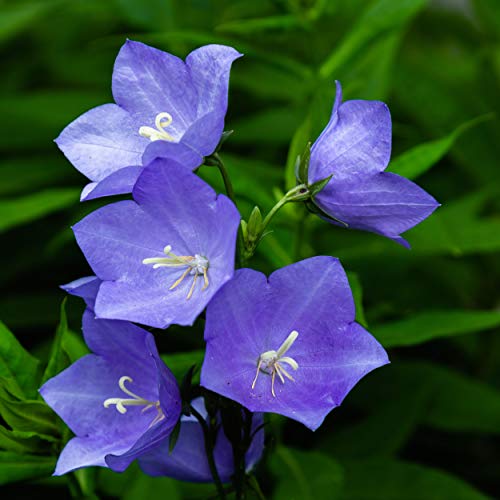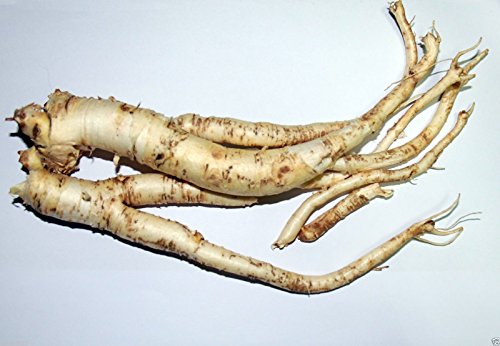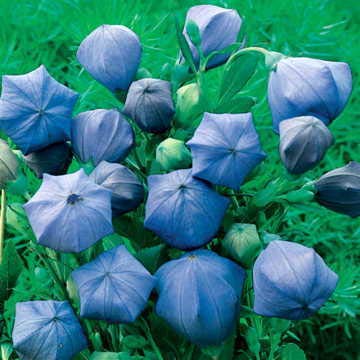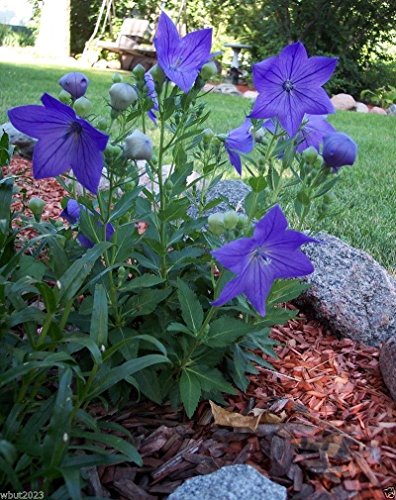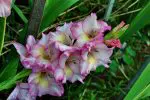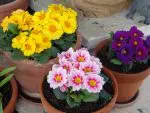This post contains affiliate links. If you buy something from one of our links we may earn a commission. Thanks
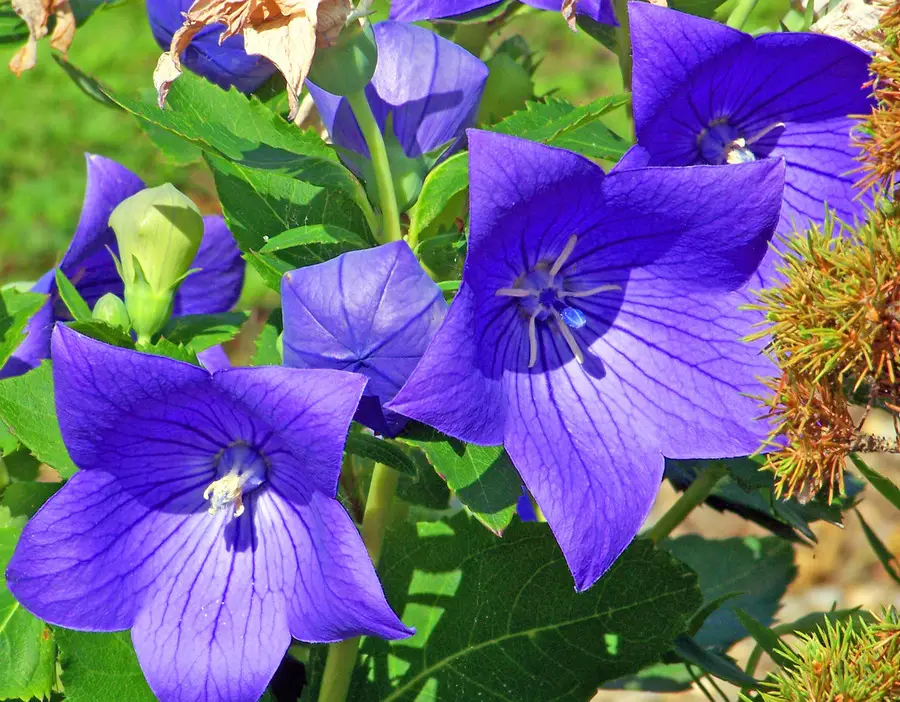
Can you grow balloon flowers in pots? Absolutely! Discover the joy and ease of cultivating these stunning blooms in your own containers. Join us!
To grow Balloon Flowers in pots, use well-draining soil and place the pot in a location with full sun to partial shade. Keep the soil consistently moist but avoid overwatering. Fertilize lightly in the spring with a balanced fertilizer. Balloon Flowers prefer cooler temperatures but are fairly adaptable. Prune spent blooms to encourage new growth.
Can you grow balloon flowers in pots? If you’re pondering this question, you’re in for a delightful surprise. Yes, you absolutely can!
With their captivating balloon-like buds and radiant blooms, balloon flowers bring a whimsical touch to any space.
Whether you have a sprawling garden or a modest balcony, growing these charming plants in pots can be a rewarding and enjoyable gardening adventure.
Let’s dive into the world of balloon flowers and explore how you can nurture these beauties right in your own pots!
Can You Grow Balloon Flowers In Pots?
 Can you grow balloon flowers in pots? Absolutely! And we’re about to take a fun journey into understanding just how easy it is.
Can you grow balloon flowers in pots? Absolutely! And we’re about to take a fun journey into understanding just how easy it is.
These stunning beauties, with their balloon-shaped buds that burst into starry blossoms, aren’t just meant for the open garden.
They can also add a unique charm to your patio, balcony, or indoor space when grown in pots.
In this post, we’ll explore everything about balloon flowers from their varieties and ideal growing conditions, to their propagation, care, and even tackling common pests and diseases.
We’ll also answer some frequently asked questions and share some tips on the best uses for these vibrant plants.
So, ready to embark on this balloon flower gardening adventure with us? Let’s get started!
Exploring the Possibility: Can Balloon Flowers Thrive in Pots?
You bet they can! Balloon flowers are wonderfully versatile and adaptable, and they’re just as happy in a pot as they are in a traditional garden bed.
And, you know what’s even better? They can be an absolute treat for the eyes when displayed on your patio or balcony, or even inside your home.
So, yes, growing balloon flowers in pots are not just a possibility it’s a delightful reality!
Potted Vs. Bedded: Comparing the Two Planting Methods
Now, you might be wondering, how does pot growing compare with traditional flower bed gardening?
Well, it’s not so much about one being better than the other. It’s about what suits your needs and circumstances best.
If you’ve got a spacious garden, balloon flowers will certainly love to spread their roots out in the ground.
But if you’re a city dweller with limited space, or you just prefer the mobility and convenience of pots, then container gardening is the way to go. Either way, balloon flowers won’t disappoint!
Pot Perks: Advantages of Growing Balloon Flowers in Containers
Growing balloon flowers in pots comes with its own set of unique advantages.
For starters, it gives you better control over the plant’s environment.
You can choose the perfect soil mix, ensuring your balloon flowers get the nutrients they need.
You can also easily move the pot to give your plant the best light conditions as the sun moves across the sky.
Plus, pots can help prevent root rot by providing excellent drainage something that’s crucial for these lovely blooms.
So, if you fancy the idea of sipping your morning coffee while admiring a pot of blooming balloon flowers on your balcony, let’s get potting!
What Are Balloon Flowers?
Have you ever watched hot air balloons slowly inflate, gradually taking their glorious shape?
Now, imagine a flower doing the same, and voila, you’ve just pictured a balloon flower!
Also known by their scientific name, Platycodon grandiflorus, these enchanting perennials are native to East Asia and are famed for their unusual balloon-like buds.
Just before they burst into star-shaped blooms, these buds inflate, much like a hot air balloon getting ready for lift-off.
They come in a palette of vibrant colors, including blues, pinks, and whites.
Whether in a flower bed, rock garden, or pot, these delightful plants are sure to catch the eye and steal the show!
In this section, we’ll dive deeper into what makes balloon flowers such a fascinating addition to any garden. According to Wikipedia:
Platycodon grandiflorus (from Ancient Greek πλατύς “wide” and κώδων “bell”) is a species of herbaceous flowering perennial plant of the family Campanulaceae, and the only member of the genus Platycodon. It is native to East Asia (China, Korea, Japan, and the Russian Far East). It is commonly known as balloon flower (referring to the balloon-shaped flower buds),Chinese bellflower, or platycodon. Platycodon grandiflorus is a perennial plant which is commonly grown in mountains and fields.
Balloon Flowers Unveiled: More than a Pretty Face
Balloon flowers are a charming spectacle in any garden, and their scientific name, Platycodon grandiflorus, gives a hint of their grandeur.
These beautiful perennials, with their balloon-like buds and vibrant blooms, are a treat to the eyes.
They offer more than just beauty, though; their unique growth pattern and structure are intriguing, providing an excellent talking point for any garden tour.
A Close Look at the Cousins: Chinese and Japanese Bellflowers
When you think of balloon flowers, you might also ponder their relations, such as the Chinese bellflower and Japanese bellflower.
While they share some similarities, it’s the balloon-like buds that set Platycodon grandiflorus apart.
This distinctive feature makes them an interesting addition to any garden, offering a delightful contrast to their more traditional relatives.
The Magic of Blooming: A Hot Air Balloon Show in Your Garden
One of the most captivating aspects of balloon flowers is their unique blossoming process.
The buds swell up just like a hot air balloon preparing for flight, creating an enchanting spectacle that’s hard to miss.
Once they reach their peak, they burst open into delightful star-shaped blooms, capturing the awe of anyone lucky enough to witness this natural phenomenon.
Tracing their Roots: From East Asia to North American Gardens
Balloon flowers originally hail from East Asia but have found their way into North American gardens, where they thrive.
Their versatility and hardiness make them an excellent choice for a variety of climates and settings.
Whether you’re creating a traditional Asian-inspired garden or looking for a unique feature for your cottage garden, balloon flowers are a great choice.
Balloon Flower Varieties: Colors
Isn’t it wonderful how Mother Nature paints with such a broad palette?
Balloon flowers are no exception to this rule, boasting a vibrant range of colors that can brighten up any garden.
In this section, we’ll take a colorful journey through the different varieties of balloon flowers.
From serene whites to electrifying blues, and soothing pinks, there’s a hue to match every gardener’s dream.
Get ready to add a splash of color to your garden knowledge as we delve into the world of balloon flower varieties!
Dazzling Blues: Fuji Blue Flowers
The most popular and eye-catching color in balloon flowers is undoubtedly the blue hue.
Among these, the Fuji Blue variety stands out with its strikingly vivid blue flowers, adding a touch of serenity to your garden.
Pure Whites: Elegant White Varieties
If you’re a fan of classic elegance, balloon flowers also come in pure white varieties.
These flowers add a touch of sophistication and grace to your garden, creating a stunning contrast against the green foliage.
Pretty in Pink: Pink Balloon Flowers
Don’t forget about the pink balloon flowers! These delightful varieties offer a warm, cheerful hue that can soften the look of your garden or container.
Pink balloon flowers can offer a charming and gentle touch to any floral setup, adding to the overall variety and appeal.
Petite Charmers: Dwarf Varieties
For those with limited space or who prefer a more delicate appearance, dwarf varieties of balloon flowers are just the ticket.
These charming little plants produce a fine texture of blooms, making them perfect for small gardens, containers, or rockeries.
ASTRA – Perennial Dwarf Balloon Seeds
Balloon Flower Height: Dwarf and Tall
Are you curious about the different sizes balloon flowers can grow to? Well, you’re in the right place!
In this section, we’re going to delve into the diverse world of balloon flower heights.
From the compact charm of dwarf varieties to the commanding presence of tall stems, balloon flowers truly offer something for every garden.
We’ll explore how these different heights can play into your gardening strategies and how they can best fit into your garden design.
So, let’s take a closer look at these fascinating plants in all their vertical glory!
Dwarf Vs. Tall Balloon Flowers: A Sizing Up
While both dwarf and tall balloon flowers bring a unique charm to any garden, it’s important to understand their differences.
Dwarf varieties, as their name suggests, maintain a compact size, typically reaching only about a foot in height.
On the other hand, tall balloon flowers can grow up to 2.5 feet tall, standing out in any garden with their lofty stems.
Ideal Conditions for Different Heights
Tall balloon flower varieties, with their long stems, often require a bit of extra support to prevent them from toppling over.
Staking can provide the necessary support for these taller plants, particularly in areas prone to heavy winds.
Dwarf varieties, being shorter, generally don’t require staking, making them a hassle-free choice for many gardeners.
Plant Height and Its Impact on Gardens
The height of your balloon flowers can greatly influence their role in your garden.
Dwarf varieties, with their low profile, are excellent for borders, rock gardens, and containers where their compact nature can be best appreciated.
Taller varieties, with their impressive height, are fantastic for providing a backdrop in garden beds or creating a visual impact as a stand-alone plant.
Understanding the height of these plants allows you to strategically place them in your garden for the best aesthetic results.
Blue Balloon Flower Growing Tips: How to Grow Balloon Flowers In Pots
Got a soft spot for those stunning blue balloon flowers and wondering how to grow them right in your own pots?
Well, you’re in luck! We’re about to dive into all the nitty-gritty details that will help you cultivate these beauties with confidence.
From optimal light conditions, watering practices, and choice of soil and pots, to fertilizing, and managing temperature and humidity, we’ll explore it all.
So, whether you’re a seasoned gardener or just starting out, these easy-to-follow tips are sure to transform your blue balloon flower pot growing journey into a delightful success!
Basking in the Glow: The Balloon Flower’s Light Needs
Sunlight Requirement: Balloon flowers thrive in full sun, meaning they need at least six hours of direct sunlight every day.
But if you live in a region with intense afternoon sun, some dappled shade can be beneficial.
Shade Tolerance: These plants can also tolerate partial shade, although they may not bloom as profusely.
This flexibility makes them suitable for a range of garden locations.
Indoor Growing: If you’re growing balloon flowers indoors or in a pot, place them near a south-facing window for optimum light.
Thirst-Quenching: Watering Your Balloon Flowers
Watering Frequency: While balloon flowers like moist soil, they don’t appreciate being waterlogged.
The rule of thumb is to water when the top inch of soil feels dry.
Deep Watering: Deep watering encourages the development of a robust root system, allowing the plants to withstand dry periods better.
Watering Technique: Water at the base of the plant to keep the foliage dry and prevent fungal diseases.
The Perfect Home: Soil, Pots, and the Role of Coco Coir
Soil Composition: Balloon flowers prefer well-drained soil that’s rich in organic matter. A loamy soil that holds moisture but also drains well is ideal.
Coco Coir: A potting mix containing coco coir and perlite can improve soil texture, enhance moisture retention, and provide good drainage.
Pot Selection: Choose pots with good drainage holes to prevent waterlogging. Remember, balloon flowers have a long taproot, so they’ll need a deep pot.
Food for Growth: Fertilizing Your Balloon Flowers
Fertilizer Type: A slow-release fertilizer provides a steady supply of nutrients, ensuring your balloon flowers don’t suffer from nutritional deficiencies.
Fertilizing Frequency: Typically, balloon flowers should be fertilized once at the start of the growing season, but if your soil is poor, additional feeding may be beneficial.
Organic Options: If you prefer organic gardening, consider enriching the soil with compost or a layer of composted manure.
Weathering the Weather: Temperature and Humidity Tolerance
Temperature Range: Balloon flowers are hardy plants that can withstand a wide range of temperatures. However, they thrive best in temperatures between 60°F and 80°F.
Humidity Tolerance: While they can handle some humidity, they prefer average to low humidity conditions. In high humidity, ensure good air circulation to prevent diseases.
Drought Tolerance: Once established, balloon flowers can tolerate short periods of drought, making them a good option for areas with occasional dry spells.
Propagation: Growing Balloon Flowers From Seed
Looking to add more balloon flowers to your garden or share the beauty with friends?
You’re in luck! Balloon flowers propagate wonderfully from seeds, and it’s not as daunting as it might sound.
In this section, we’ll share some handy tips on how to successfully grow balloon flowers from seed.
Whether you’re a seasoned gardener or just starting, we’ll guide you through the process, from sowing seeds to nurturing new plants.
Get ready to see your garden flourish with the delightful pops of color from these charming blooms!
Sowing Seeds and Caring for Young Plants:
Starting off: You’ll want to sow seeds in early spring for the best results.
Let’s walk you through the process, making sure you’re prepared to care for these young plants as they start their growth journey.
Seed preparation: Interestingly, the seed pods of balloon flowers are quite distinct, so you’ll have no trouble identifying them!
We’ll discuss how to collect and prepare these seeds for planting.
Ideal Conditions for New Growth:
Creating the perfect environment: Just like people, plants thrive in the right conditions.
We’ll delve into what makes the perfect environment for balloon flower seeds to sprout and grow.
Seed Preparation:
The process of preparing balloon flower seeds for planting is a fascinating one.
The seed pods of balloon flowers are quite unique, resembling small, roundish capsules.
When they’re mature and dry, they open up, revealing numerous small seeds inside.
Identifying Seed Pods: The first step in seed preparation is identifying the right time to collect the seeds.
You’ll know the seed pods are ready when they turn brown and dry. This usually happens in late summer or early fall.
The pods will appear inflated and ready to burst – a sign that it’s time to collect the seeds.
Collecting Seeds: To collect the seeds, simply snip off the pods and place them in a paper bag.
Let them dry out for a few more days in the bag. As the pods dry, they will open up, and the seeds will fall out into the bag.
If you don’t have seed pods you can buy seeds online here.
Cleaning and Storing Seeds: Once the seeds have been collected, you’ll want to clean them off.
Remove any remaining chaff and pod material. After cleaning, store the seeds in a cool, dry place in a sealed container until you’re ready to plant them.
Remember, it’s important to keep them away from high humidity levels to prevent any potential fungal growth.
Seed Stratification: Balloon flower seeds need a period of cold stratification before they can germinate.
This means they need to be exposed to a cold and moist environment for a few weeks.
This can be achieved by placing the seeds in a plastic bag with some moist sand or peat moss and then storing them in the refrigerator for about four to six weeks.
After this period, they will be ready to be sowed.
Sowing Seeds: When it’s time to plant, sow the stratified seeds on top of a seed starting mix, but don’t cover them as they need light to germinate.
Keep the soil moist and in a warm location. Germination should occur in about two to three weeks.
The entire process, from seed collection to germination, is a rewarding experience, and you’ll find great joy in seeing those little seedlings sprout and grow into beautiful balloon flowers!
Timing: Timing is everything, and we’ll discuss the ideal season and conditions for your seeds to take off.
Let’s break down the best times and conditions to give your seeds the best chance to thrive.
The season for Sowing: Balloon flowers are usually sown in early spring.
This is when conditions are ideal for the seeds to germinate and establish themselves.
Starting your seeds indoors about 6-8 weeks before the last expected frost date can give them a head start.
Outdoor Transplanting: If you’ve started your seeds indoors, you’ll want to wait until after the danger of frost has passed before transplanting them outdoors. This typically falls in late spring.
Seed Stratification Timing: Remember, balloon flower seeds require a period of cold stratification before they can germinate.
Start this process in winter, about 4-6 weeks before you plan to start your seeds indoors.
Balloon flowers are late bloomers: They typically start to bloom in late July and continue through the end of summer.
If you’ve timed your planting right, you should see your first ‘balloons’ around this time.
Maturation Time: Keep in mind that balloon flowers, especially those grown from seed, may take a while to mature fully and may not flower in the first year. Patience is key here!
In summary, timing your seed sowing and transplanting correctly, considering your local climate and the specific needs of balloon flowers, will set you up for a successful growing season.
Handling the Long Taproot When Transplanting:
The importance of the taproot: The balloon flower has a long taproot, which is essential for its growth and survival.
We’ll discuss why it’s so vital and how to take care of it when transplanting.
Transplanting tips: Transplanting can be a tricky business, especially with a plant that has a long taproot.
We’ll share some tips and tricks to ensure a smooth transition and avoid damaging this critical part of the plant.
Preparation: Before you begin the transplanting process, make sure you have all your tools ready.
This includes a shovel or a trowel, a new pot or garden bed ready for planting, and water for hydration after the move.
Transplanting the Plant: plant for transplanting, be gentle and water the plant before transplanting.
Place one hand across the top of the container and turn it upside down while gently squeezing the sides of the pot until the plant slides out easily.
The goal is to keep as much of the root structure intact as possible.
Handling the Taproot: The taproot is the main root from which other roots sprout, and it dives deep into the soil.
It’s essential to handle it with care. If it gets damaged, the plant might struggle to establish itself in its new location.
Depth of Planting: When you’re transplanting the plant, whether into another container or out in the garden ensure that the taproot is planted deep enough in the new location.
The hole should be deep enough to accommodate the taproot fully without bending or breaking it.
Soil Conditions: Balloon flowers prefer well-drained soil. Use the same coco coir and perlite mix you started the seeds into transplant into a larger container.
Make sure any new location in the garden has good drainage to prevent waterlogging, which could harm the taproot and cause root rot.
Post-Transplant Care: After transplanting, water the plant well to help it settle in its new home.
However, be mindful not to overwater, as this can lead to root rot. Regular but moderate watering is the key to helping your transplanted balloon flower thrive.
Remember, the process of transplanting can be stressful for plants, so don’t worry if your balloon flower seems a bit sluggish or droopy after the move.
Give it some time to adjust to its new environment, and with proper care, it should bounce back in no time!
Pruning and Maintenance
Dedicated to growing balloon flowers, but unsure about their pruning and maintenance?
Well, you’re in the right place! This section is all about keeping your balloon flowers in prime condition.
We’ll discuss when and how to prune, what to look out for during the growth period, and how to maintain your plants for a stunning bloom season after season.
Ready to get your hands a little dirty? Let’s dive into the world of balloon flower care!
Pruning Time and Techniques:
Knowing when to prune is crucial. Balloon flowers typically benefit from pruning in early to late spring.
This helps promote new growth and maintain plant health. Regular pruning also helps the plant focus its energy on producing vibrant blooms.
Managing Spent Flowers and Seed Pods:
Once your balloon flowers have bloomed, you’ll start to see spent flowers and seed pods.
Carefully removing these can stimulate further blooming. Seed pods can also be collected if you plan to propagate new plants.
Compost and Mulch for Soil Health:
A layer of compost or mulch applied around the base of the plant can do wonders.
It enriches the soil with organic matter and helps retain moisture. This is especially beneficial during hot summers or dry periods. Plus, mulch can act as a barrier against certain pests!
Care for the Root System:
Balloon flower plants have a long taproot, which means they don’t like to be disturbed once planted.
So, while adding compost or mulch, make sure to avoid the root area to prevent any damage.
Remember, every plant is unique and may respond differently to pruning and maintenance.
Keep an eye on your balloon flowers to understand what works best for them!
Managing Pests and Diseases
Ready to tackle the not-so-pleasant part of gardening?
While our beloved balloon flowers are hardy plants and generally resistant to most pests and diseases, it’s always a good idea to be prepared.
In this section, we’ll delve into the common pests and diseases that might trouble your balloon flowers and offer tips on how to prevent and manage these issues.
Remember, a healthy plant is the best defense against pests and diseases, so let’s dive in and ensure our garden stays in tip-top shape!
Common Pests and Diseases:
Balloon flowers are quite hardy and typically don’t have many problems with pests or diseases, but as with any plant, they are not completely immune.
Here are some potential issues:
Pests: The most common pests that might affect balloon flowers are aphids and slugs.
Aphids are small, soft-bodied insects that feed on plant sap, usually clustering on new growth.
Slugs, on the other hand, are nocturnal creatures that feed on leaves and can cause significant damage.
Aphids: If you notice a small population of aphids, you can often simply wash them off with a strong spray of water.
For larger infestations, insecticidal soap or neem oil can be effective.
Slugs: To deter slugs, you can use slug pellets or traps. Alternatively, diatomaceous earth sprinkled around the plants can be an effective natural deterrent.
Diseases: Balloon flowers are not particularly prone to any specific diseases.
However, like all plants, they can be susceptible to fungal diseases, particularly in wet conditions or if they’re not properly cared for.
Root Rot: This is usually caused by overwatering or poor drainage.
The best prevention is to ensure your balloon flowers are planted in well-draining soil and not overwatered.
If root rot does occur, you may need to remove and discard the affected plant to prevent the disease from spreading.
Powdery Mildew: This is a fungal disease that appears as a white powdery deposit over the leaf surface and stems.
Good air circulation, proper watering, and a fungicide can help control this disease.
Preventing Pests and Diseases:
Remember, the key to managing pests and diseases is regular observation and early intervention. Spotting a problem early often makes it much easier to control!
Prevention is the best medicine in a garden too! Here, we’ll share some tips and techniques to keep your balloon flowers healthy and deter pests and diseases.
Deer-Resistant Properties:
One of the fascinating things about balloon flowers is their deer-resistant properties.
If you’ve ever experienced the frustration of finding your carefully nurtured plants nibbled by deer, you’ll appreciate this quality!
Deer Deterrence: Deer, like most animals, are selective about what they eat.
Certain plants have developed characteristics that make them less appealing to deer.
In the case of balloon flowers, it’s not entirely clear what discourages deer, but it could be the texture or taste of the leaves.
Reliability: While no plant is completely deer-proof, balloon flowers are on the list of those least likely to be eaten by deer.
This makes them a reliable choice for gardens in areas with high deer activity.
Garden Planning: Incorporating deer-resistant plants like balloon flowers into your garden can help protect more susceptible plants.
By providing plants that aren’t appealing to deer, you can help steer them away from your favorite blooms.
Other Pests: It’s also worth noting that in addition to being deer-resistant, balloon flowers aren’t typically bothered by many common garden pests.
This adds to their appeal as a hardy, low-maintenance plant for your garden.
So, if you’re in an area with a high deer population, balloon flowers could be a great addition to your garden.
They not only bring beauty but also provide some natural defense against these common garden visitors.
Cultivars to Select
Are you excited to start your balloon flower adventure but unsure about which cultivars to choose from?
Don’t worry, we’re here to help! In this section, we will explore some of the most popular and vibrant cultivars of Platycodon grandiflorus.
From the stunning Fuji Blue to the delicate Apoyama, and the compact Pop Star, we’ve got you covered.
Whether you’re looking for a tall, show-stopping plant or something a bit more low-key, there’s a balloon flower for every garden and pot.
Let’s dive into the wonderful world of balloon flower cultivars!
Pop Star Balloon Flower: The Show-Stopper
The Pop Star Balloon Flower is a true star of the garden show. This cultivar’s compact size makes it an ideal choice for container gardening or small spaces.
Despite its petite size, it doesn’t hold back on bloom production. During the flowering season, it produces an abundance of bright purple-blue flowers that certainly grab attention.
What’s more, it’s easy to maintain, requiring only regular watering and a sunny spot to thrive. With the Pop Star Balloon Flower, you’re sure to have a winning addition to your garden or balcony.
Fuji Blue: The Blue Wonder
Fuji Blue is an impressive variety that stands out with its vibrant blue flowers.
This cultivar grows to a medium height, making it suitable for use as a border plant or in mixed flower beds.
What sets Fuji Blue apart is its striking color which can add a refreshing touch to your garden.
It thrives in full sun to partial shade and prefers well-drained soil. If you’re looking to add a burst of blue to your garden, the Fuji Blue Balloon Flower is a stunning choice.
Apoyama: The Subtle Elegance
Apoyama is a less common but no less beautiful balloon flower variety.
It is smaller than many other varieties, making it a great choice for rock gardens or borders.
Apoyama produces charming white flowers that offer a softer color palette for your garden.
It’s a perfect choice if you prefer understated elegance over bold colors. Like other balloon flowers, it thrives in well-drained soil and can handle full sun to partial shade.
Other Noteworthy Cultivars: Exploring the Spectrum
The world of balloon flowers is wide and varied, and there are many other cultivars to consider.
For instance, the ‘Sentimental Blue‘ is a dwarf variety that grows only about a foot tall, perfect for small spaces or container gardens. Its deep blue flowers are a sight to behold.
Then there’s the ‘Double Blue,’ which offers double the petals for an even more impressive display.
On the other hand, ‘Komachi‘ is a unique variety where the flowers remain in their balloon-like bud shape, giving the plant an interesting and distinctive appearance.
Each of these varieties brings something unique to the table, expanding the range of choices for balloon flower enthusiasts.
Best Uses For Balloon Flowers
If you’re searching for versatile and eye-catching plants to elevate your garden or containers, balloon flowers might be just the ticket.
In this section, we’ll explore the best uses for these captivating blooms, from creating stunning mixed beds and borders to adding a pop of color to your rock gardens.
With their unique balloon-like buds and enchanting bell-shaped flowers, balloon flowers can truly transform your garden into a visual wonderland.
So let’s dive into the various ways you can incorporate these beauties into your outdoor spaces and watch your garden come alive!
Enhancing Garden Styles with Balloon Flowers
Rock Gardens: Balloon flowers, with their unique shape and vibrant colors, are a perfect addition to rock gardens.
Their hardy nature allows them to thrive in the challenging conditions often found in these landscapes, and their distinctive blooms provide a striking contrast against the stony backdrop.
Cottage Gardens: In the more traditional setting of a cottage garden, balloon flowers fit right in with their old-world charm.
The taller varieties can add height and structure, while dwarf varieties fill in the lower strata with bursts of color.
They can be artfully paired with other perennials to create a scene straight out of a storybook.
Incorporating Balloon Plants into Container Gardens
‘Spiller-Thriller-Filler’ Combination: When planting in containers, consider the ‘spiller-thriller-filler’ concept.
In this arrangement, the ‘thriller’ is the centerpiece of the pot, the ‘filler’ plants surround it, filling up space, and the ‘spillers’ trail over the sides of the pot.
Balloon flowers can serve as a superb ‘thriller’ with their eye-catching blooms, or as a ‘filler’ providing a dense, colorful backdrop for other plants.
Spiller-Thriller-Filler Explained
The ‘Spiller-Thriller-Filler’ combination is a method often used by gardeners and landscapers to design visually captivating container gardens.
Here’s what each term represents:
‘Thriller’: These are the star of the show, the plants that draw your attention immediately due to their height, color, or unique structure.
They are usually placed either in the center or at the back of the container.
In the context of balloon flowers, these plants would serve as an excellent ‘thriller’ due to their unique balloon-like buds and vibrant blooms.
Other ‘thrillers’ could include plants like canna lilies, ornamental grasses, or upright fuchsias.
‘Filler’: These are plants that complement the ‘thriller’ by filling the space around it.
They are generally shorter and help to add volume and color to the arrangement.
Good ‘filler’ options might include petunias, begonias, or impatiens.
‘Spiller’: These plants trail over the edge of the container, creating a cascading effect that adds dimension and interest.
They give the arrangement a sense of fullness and movement.
Examples of ‘spillers’ could be trailing lobelia, creeping thyme, or sweet potato vine.
The ‘Spiller-Thriller-Filler’ concept can be adapted to any style or size of container garden, and the plant choices can be varied to fit the specific conditions and aesthetics desired.
Using Balloon Flowers as Cut Flowers
From Vase to Table: The beauty of balloon flowers isn’t limited to the garden.
They make excellent cut flowers as well, adding a pop of color to any indoor space.
Whether arranged in a simple vase or incorporated into a larger floral design, balloon flowers maintain their vibrancy for several days, making them a great choice for fresh bouquets or even as a centerpiece for your table.
Balloon Flower FAQ
Let’s step into the world of frequently asked questions about the delightful balloon flowers.
From their bloom season to winter care, we’ll demystify some common curiosities you might have about this unique plant.
Q: Do balloon flowers come back every year?
A: Absolutely! Balloon flowers are perennial plants, which means they’re designed to grace your garden with their presence year after year.
Q: Do balloon flowers spread?
A: Balloon flowers do spread but in a polite way. They aren’t aggressive spreaders, but you’ll see them gently expand their territory over time.
Q: How long do balloon flowers last?
A: The individual blooms of a balloon flower usually last for about a week, but don’t worry – new ones will take their place. The blooming period for these plants typically spans several weeks in the summer.
Q: What do you do with balloon flowers in the winter?
A: Balloon flowers are pretty hardy, and they can handle winter conditions in many climates. However, a layer of mulch can provide extra protection against the cold. It’s also best to leave the stems until early spring before cutting them back.
Q: How cold can balloon flowers tolerate?
A: These plants are quite cold-hardy and can typically tolerate winter temperatures as low as -30°F, which is equivalent to USDA hardiness zone 4.
Q: What month do balloon flowers bloom?
A: Balloon flowers generally start to bloom in late July and can continue into September. Their starry, bell-shaped blooms are well worth the wait!
Can You Grow Balloon Flowers In Pots? Final Thoughts
As we wrap up our delightful journey exploring the world of balloon flowers, I hope you’re filled with the inspiration and practical knowledge to grow these charming plants.
Whether you’re a seasoned green thumb or a gardening novice, you’re now armed with all the tips, tricks, and insights needed to successfully grow balloon flowers in pots, beds, or borders.
Ready to turn your garden into a vibrant oasis with these balloon-like beauties? Let’s get planting!
Recap of the Journey:
We’ve delved into the enchanting world of balloon flowers, particularly the Platycodon grandiflorus, uncovering the charm and appeal of these unique plants.
From their balloon-like buds to their vibrant colors and variety of heights, these plants bring a distinctive touch to any garden.
The Appeal of Balloon Flowers:
These plants aren’t just visually appealing; they’re also notably low-maintenance.
Whether you’re a seasoned gardener or a beginner, balloon flowers offer an easy way to add a pop of color and interest to your green spaces.
With their deer-resistant properties and tolerance for various conditions, they’re a hardy choice for many gardens.
The Versatility of Balloon Flowers:
The versatility of balloon flowers allows them to thrive in various settings be it in pots for a balcony garden or in open flower beds in a larger garden.
They’re equally at home in rock gardens, cottage gardens, or as part of a ‘spiller-thriller-filler’ container combination.
The Final Call:
So, are you ready to add these delightful balloon flowers to your garden?
With the practical knowledge and tips we’ve shared, you’re all set to grow these beauties successfully.
Whether you choose the dwarf varieties for their compact charm or the tall ones for their striking presence, balloon flowers are ready to transform your garden into a captivating space. Let’s get planting!
Read more: Backyard Gardening Ideas: Easy Garden Ideas For Beginners









